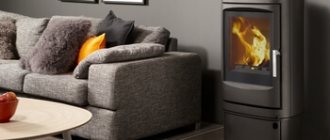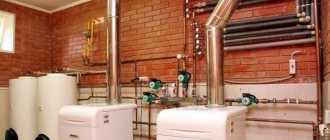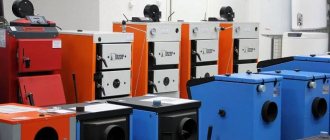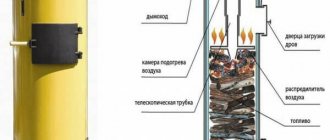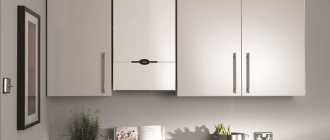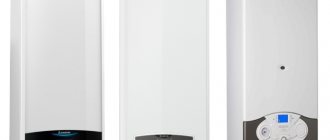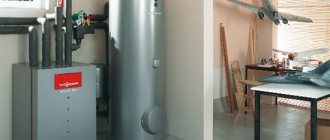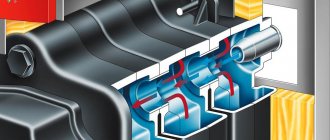Boiler KSts-GV-31.5. KSts-G-20N with burner AGU-T-M-35ts(28)(23)ts
1. Firebox 2. Smoke pipe 3. Coil 4. Water jacket 5. Turbulizer 6. Chimney 7. Damper 8. Insulation 9. Bottom pipe 10. Top pipe 11. Casing 12. Cover 13. Guard 14. Burner 15. Temperature sensor 16.Thermometer
5.2.5 Boilers KS-T-…; KS-TG-…; KS-TGV-... (Fig. 4,5,6) consist of a furnace 16(14), equipped for burning solid fuel and gas and a convective flue 17(15). In the lower part of the firebox, grates 13 and a beam are installed, forming the grate web. To ensure complete washing of the heating surface with flue gases and improve the operation of the boiler, the rear wall of the upper part of the firebox is made in the form of a cooled canopy. On the front surface of the boiler, loading doors 1 and screwing doors 2 are attached, through which fuel is loaded, the grate is cleaned, as well as the surface of the firebox and convective chimney are cleaned.
Boiler KS-TVm-16
1.Loading door 2.Loading door 3.Primary air damper 4.Pipe for connection to the smoke channel 5.Draft control damper 6.Casing 7.Pipe for connection to the supply pipeline of the heating system 8.Turbulizer 9.Thermometer 10.Insulation 11 .Water jacket 12. Shield 13. Grate 14. Water heater 15. Coil 16. Boiler furnace 17. Convective gas outlet area 18. Pipe for connection to the return pipeline of the heating system
Boiler KS-T-16
1.Loading door 2.Loading door 3.Primary air damper 4.Pipe for connection to the smoke channel 5.Draft control damper 6.Casing 7.Pipe for connection to the supply pipeline of the heating system 8.Turbulizer 9.Thermometer 10.Insulation 11 .Water jacket 12. Shield 13. Grate 14. Boiler furnace 15. Convective gas exit zone 16. Pipe for connection to the return pipeline of the heating system
Boiler KS-TV-31.5; KS-TGV-31.5N; KS=TGV-31.5/40N
1.Loading door 2.Loading door 3.Primary air damper 4.Pipe for connection to the smoke channel 5.Draft control damper 6.Casing 7.Pipe for connection to the supply pipeline of the heating system 8.Turbulizer 9.Thermometer 10.Insulation 11 .Water jacket 12. Shield 13. Grate 14. Water heater 15. Coil 16. Boiler furnace 17. Convective gas exit zone 18. Pipe for connection to the return pipeline of the heating system 19. Hatch for soot cleaning
To provide hot water, the boiler has a coil 3 (Fig. 1, 2, 3), which is located in a hot water environment. When water from the plumbing system passes through it, the water in the coil heats up. Adjustment of the required water temperature is achieved with a mixer. In the absence of a mixer, adjusting the water temperature is achieved by increasing or decreasing the speed of water passing through the coil using a valve. 5.2.5.1 Construction of a natural gas boiler In a boiler for burning natural gas, instead of grates, a scramble door and a cast iron frame, a gas burner device with automation is mounted. On all boilers operating on natural gas, a combustion plate is installed in the upper part of the firebox close to the front wall. 5.2.5.2 The procedure and principle of operation of the gas burner device is described in the attached operating manual for the gas burner device.
6. INSTALLATION OF BOILER AND HEATING SYSTEM
ATTENTION! Installation of a heating boiler should only be carried out by gas service specialists with a mark in the passport!
6.1 The gas burner device is stored in a separate package. To avoid damage, boilers must be transported in containers directly to the installation site. 6.2 When installing on combustible building structures, 0.5 m below the boiler and in front of its front, it is necessary to install a steel sheet gasket over asbestos cardboard or felt soaked in clay mortar. 6.3 In order to improve the conditions of water circulation in the heating system, the boiler must be installed in such a way that its lower pipe (see Fig. 1,3, item 9) is lower than the radiators of the heating system of the building (structure).
6.4 Pipelines are made from water pipes. Pipe connections can be made by threading and welding. 6.5 When installing pipelines by welding, threaded connections should be left to ensure disassembly of the system during repairs. 6.6 Recommended installation dimensions for radiators when installing residential heating: a) from the wall to the radiator no less than 3 cm; b) from the floor to the bottom of the radiator – 10 cm; c) from the top of the radiator to the window sill - at least 10 cm. d) When installing the radiator in a niche, the distance from the radiator to the side wall of the niche is at least 10 cm on each side. 6.7 When bending pipes, the radius must be at least 2 outer diameters of the pipe. 6.8 When laying pipes, risers must be installed plumb. The permissible deviation should not exceed 3 mm over 3 meters of pipe length. 6.9 Horizontal pipelines must be laid with a slope to allow air to escape from the system. The slope must be at least 10 mm per 1 linear line. meter of pipeline. In this case, the slopes of the branches to the heating device must be at least 10 mm over the entire length of the line towards the heating device. 6.10 If there are more than one boilers in the system, a plug valve or valve is installed on the return line to each boiler. 6.11 The boiler installation diagram is shown in the figures.
Installation diagram of the KS-G boiler. -12.. Connection of the boiler with a brick chimney and cleaning device
Installation diagram of the KSts-G boiler. -.. Connection of the boiler with a brick chimney and cleaning device
Installation diagram of the KS-T boiler. -16.. Connection of the boiler with a brick chimney and cleaning device
Installation diagram of the KS-T boiler. -31.5..; KS-GV-50.. Connection of the boiler with a brick chimney and cleaning device
Installation diagram of the KSts-G boiler. -.. Connection of the boiler with an asbestos-cement pipe Du-200
Installation diagram of the KS-TV-31.5 boiler. -..; KS-GV-50N Connection of the boiler with an asbestos-cement pipe Du-200
6.12 The chimney structure must meet the following requirements: the chimney to which the boiler is connected must be located in the internal main wall of the building. Smoke exhaust pipes laid through unheated rooms must, if necessary, be covered with thermal insulation. It is allowed to connect heating boilers to chimneys made of asbestos-cement pipes. The chimney installation must be agreed upon with the fire authorities. To ensure fire safety and avoid gas contamination in the room, the chimney must be installed above the roof level in accordance with the requirements of SNIP 2.04.08-87. 6.13 The cross-sectional area of the chimney should not be less than the area of the boiler pipe connected to the chimney (see Table No. 1). 6.14 Chimneys must be vertical, without ledges. 6.15 The diameters of the heating system pipelines are selected using a special calculation. The most common diameters are: - main boiler riser - 1¾-2ıı - distribution and collection lines - 1¼ - 1½ıı - connections to devices - ¾ - 1ıı 6.16 Heating boilers can be installed in a closed heating system with a membrane-type expansion tank. 6.17 When connecting the boiler coil to the hot water supply system, connect the cold water to the lower pipe, and the hot water outlet to the upper pipe. The pressure in the heating system in operating condition, at a water temperature in the heating system of 60º-80ºС, should not exceed the operating water pressure indicated in the table. 1 point 4 of the manual, that is, 0.12 MPa (1.2 kgf/cm2) or 0.2 MPa (2.0 kgf/cm2) for KSts boilers…. A safety valve should be installed on the riser, adjusted to a pressure of 0.15 MPa (1.5 ± kgf/cm2) or 0.18 MPa (1.8 kgf/cm2) for KSts boilers…. To control the pressure in the heating system, a pressure gauge with a measurement limit of 0-4 kgf/cm2 must be installed.
Advantages and disadvantages
Before purchasing a unit, you need to find out about its advantages and disadvantages. In addition to the fact that the boiler is low in cost, it has a number of other advantages. Among them are:
- service life - 25 years;
- additional equipment allows you to quickly convert the boiler from one fuel to another;
- thanks to its simple design, the unit is easy to clean, repair and replace damaged parts;
- a sectional heat exchanger makes it possible to create a large range of capacities;
- The features of the device and thermal insulation increase the efficiency of the equipment even when using wet firewood (humidity should not exceed 20%).
The disadvantage is that the KChM-5 has a significant gas and coal consumption, while one load of fuel allows the boiler to operate for a short time. If we compare this model and pyrolysis devices, the latter have a number of advantages. Insufficient efficiency entails the need to periodically clean the internal surface of the device. You also need to properly organize the chimney, otherwise combustion products will enter the room.
Comparison with analogues
Solid fuel boilers KChM-5 can be considered universal in their design. Their heat exchangers are cast iron sections. This distinguishes the model from its analogues. Moreover, the greater the power of the unit, the more sections are included in its design.
A feature of the boiler is its ability to be converted to work with other fuel. A long-burning pellet boiler operating in automatic mode can be assembled. To do this, you just need to install a pellet burner and a hopper with an auger supplying fuel. You can get a KChM gas boiler through a simple modification. You just need to replace the fuel burner.
In terms of its technical characteristics, the KChM differs from its analogues. A comparison of the main indicators for models with a power of 40 kW is shown in the table below.
AGV design
The AOGV gas boiler has a gas-tube design with a vertical flame tube and is installed on the floor. The round burner is located at the bottom. The air required for combustion enters through the lower holes in the casing. Removal of combustion products occurs naturally, through the chimney pipe at the top, at the base of which there is a draft breaker cap with a door.
Design of the AGV-80 gas unit
The flame tube is divided into sections by so-called turbulators, which provoke turbulence in the flow of exhaust gases, reduce its speed and increase the efficiency of the device.
The connection pipe for the direct line of the heating system is mounted on the top cover of the boiler. Returns are on the side. The AGV-80 gas boiler differs from the AGV-120 in that the fuel line with shut-off valves is located on the outside and does not have a casing.
In combined models (with the letter “K”) there is a coil that wraps around the flame tube from the inside. It supplies hot water to the water supply system.
The boiler automation stops the gas supply in three cases:
- When traction drops.
- Pressure drop in the fuel line.
- Flame breakout or arbitrary cessation of combustion.
No connection to electrical networks is required, the device is completely autonomous. The boiler casing is made round or square, which depends on the type of design - “Economy”, “Universal” or “Comfort”.
Design of the AGV-120 gas unit
Installation and operation rules
When installing a boiler, it is necessary to fulfill certain requirements related to fire safety. This will increase the service life of the solid fuel boiler and ensure safety and comfort.
When installing the boiler in a suitable room, it is important to maintain the distance from the unit to the walls: from the back surface to the wall at least 250 mm, to the side surfaces at least 100 mm
To ensure access to the rear surface of the boiler during installation and maintenance, it is necessary to maintain a distance of at least 400 mm from one side. A free space of about 1 sq.m. is provided in front of the boiler to ensure easy loading of fuel and cleaning of the ash pan.
The heating installation is placed on a reliable base, finished with fire-resistant materials, or on a platform. The fuel is placed at a distance of 400 mm from the boiler. The coolant is used prepared, without impurities, to avoid the formation of deposits, which can reduce the service life. The equipment is suitable for operation in systems with both natural and forced coolant circulation.
It is important to protect the boiler from overheating when the water temperature has reached the maximum value and the fuel continues to burn. This phenomenon can be avoided by using: a thermostatic draft regulator, using a cooling heat exchanger, a switching valve or installing a heat storage tank
This phenomenon can be avoided by using: a thermostatic draft regulator, using a cooling heat exchanger, a switching valve or installing a heat storage tank.
How does KChM 5 differ from its analogues?
The name “KChM” stands for “modernized cast iron boiler.” Cast iron boilers running on solid fuel are considered one of the most expensive and reliable. Compared to the same steel counterparts, cast iron ones are 1.5 times more expensive. This is explained, first of all, by the high cost of cast iron and the high costs associated with casting this metal.
Despite this, the cost of a cast iron boiler from the Kirov plant is several times lower than the price of similar models from foreign manufacturers.
The main difference between KChM 5 is its multi-fuel capability: the device can operate on solid fuels (coal, firewood, peat), liquid fuel (kerosene, gasoline, oil) and gaseous (natural or liquefied gas). Operation on liquid and gas fuel requires modification of the device, which is provided by the manufacturer.
The purpose of the KChM is to provide heat and hot water to residential buildings, public buildings and industrial facilities.
Initially, the boiler is manufactured with one circuit, but the manufacturer provides technical solutions that can implement the possibility of connecting a second circuit to provide the facility with hot water.
User opinions about this device do not always coincide in their assessments. Most speak highly of the boiler, assuring that the device is completely satisfactory.
The KChM 5 boiler, reviews of which are indicated above, is also often condemned by users for the small volume of ash pans. The insufficient volume of the ash chamber forces you to clean the ash pan more often than you would like.
Among the negative reviews about the KChM 5 boiler, there are also mentions that the heat-resistant grille of the heating device requires modification or replacement, since due to a design error it tends to crack at ultra-high temperatures.
In addition to the above-mentioned disadvantages of the boiler, users otherwise respond extremely positively to the device, especially noting its relatively low cost, high power and modern design.
Description of the solid fuel boiler KChM 5K 8 sections
The KChM 5 COMBI universal boiler is intended for heat supply of individual houses and buildings for municipal purposes, equipped with water heating systems with natural or forced circulation, manufactured according to technical specifications and in accordance with GOST 20548, belongs to the category of heating water heating devices with an open combustion chamber.
The KChM 5 COMBI boiler is available in two versions: for the domestic market and for export supplies. Boilers intended for the domestic market are branded “Combi”, boilers intended for export supplies are branded “Vidra”. Vidra boilers are assembled without the use of asbestos-containing materials.
The boiler is designed to burn:
- solid fuel: sorted anthracite (main, calculated), brown coal in accordance with GOST 14834-86, hard coal GOST 8163-87, firewood in accordance with GOST 3243-88, peat briquettes GOST 9963-84, milled peat GOST 13672-76
- gas fuel: low pressure natural gas GOST 5542-87, liquefied gas GOST 20448-90
- liquid fuel: liquid fuel GOST 305-82, heating oil, waste oil, fuel oil, etc.
Construction of the KChM 5 K boiler
In the rear section of the boiler, in the upper part there is a chimney pipe and a heating water flange, in the lower part there is a return water flange. A cover for cleaning the convective surfaces of the chimney, loading, screwing and ash doors are attached to the front section. The door is separated from the firebox by a shield.
The boiler package is insulated with healthy mineral insulation, which reduces heat loss to the environment. The steel casing is covered with high-quality paint.
The smoke damper of the chimney pipe regulates the exit of combustion products from the boiler into the chimney. It is controlled by a handle at the top of the chimney pipe.
The opening size of the ash door determines the amount of combustion air supplied to the combustion chamber. It is controlled using the draft regulator or manually with an adjusting screw on it.
The hole in the loading door serves to supply secondary air to the firebox.
In boilers with up to five sections inclusive, a partition sheet is installed between the front and middle sections, extending the convective flue of the boiler. When using gaseous and liquid fuels, the partition sheet is installed on boilers of all sections.
To determine the temperature of the boiler water, a capillary thermometer is installed in the water cavity of the front section.
Complete set of delivery of solid fuel boiler KChM 5K 8s:
1. Universal hot water cast iron sectional boiler - 1 pc.
2. Accessories.
3. Operation manual. Passport.
4. Operating manuals and data sheets for components.
Vimana company, Surgut - gasification, gas supply, gas supply
Wall-mounted gas boilers: detailed description, technical characteristics, varieties and manufacturers
A wall-mounted gas heating boiler is perhaps the main purchase when supplying gas to a private home. Due to its light weight and compact size, this device will fit into any environment, be it a kitchen, bathroom, pantry, attic, basement or separate boiler room. As a rule, due to restrictions on size and power, wall-mounted gas boilers are capable of heating a living area of up to 500 square meters, which is enough for most urban and suburban housing projects.
Characteristics of wall-mounted gas boilers
All gas boilers can be divided into several groups depending on their inherent features according to various parameters:
Number of circuits
There are wall-mounted gas boilers with one or two heating circuits. Single-circuit heating boilers are capable of heating only one branch - the heating branch, while double-circuit wall-mounted boilers allow you to simultaneously heat the house and heat water.
Combustion chamber view
Wall-mounted gas boilers with an open combustion chamber provide energy independence, but require a separate room with good ventilation for air intake. This problem can be avoided by devices with a closed combustion chamber, which require a coaxial chimney and a network connection to operate.
Total heating power
As a rule, single-circuit wall-mounted heating boilers have less power than double-circuit heating boilers, and their efficiency can be calculated using the formula 10 square meters of room per 1 kW of boiler power. For double-circuit wall-mounted boilers, the planned volume of hot water consumption must be added to the calculation formula.
Gas consumption
The more powerful the wall-mounted boiler, the more gas it will consume. Do not forget that in the spring-autumn period the heating can be turned on only at night, which allows you to reduce consumption by 3-4 times compared to winter.
Performance
The performance of wall-mounted gas boilers is characterized in volumes of water heated to a certain temperature in one minute, and is measured in liters per minute. No less important is the maximum heating temperature and the ratio of gas costs to the volume of heated water.
Dimensions
Typically, wall-mounted gas heating boilers are quite compact and are no larger in size than a washing machine. So, the height of the boiler is from 65 to 85 centimeters, and the weight is in the range of 30-40 kg.
Installation of wall-mounted gas boilers
All wall-mounted gas boilers consist of:
- Control and automation unit
- Circulation pump
- Expansion tank
- Gas-burner
- Heat exchanger
- Fan for forced removal of combustion products
- Safety group - safety valves, thermometer and pressure gauge
Of course, manufacturers strive to make improvements and modifications to the design, so it’s worth sorting out all the elements in order.
Control and automation unit
In wall-mounted gas boilers this is one of the most important elements. He is responsible for the operation and safety of all equipment. Pressure, draft, temperature, network voltage - all these parameters are measured and adjusted by controllers. We can say that the control unit is the brains of the heating boiler.
Circulation pump
The pump creates conditions for the free flow of water in the heating system. Usually, up to two pumps are installed that have a post-circulation mode - after the boiler is turned off, hot water continues to circulate for some time to avoid boiling inside the pipes.
Expansion tank
The main purpose is to retain excess water when heated and thereby reduce pressure in the pipes. A very important component of wall-mounted gas boilers, responsible for the overall safety of the system.
Gas-burner
The gas burner is the heart of a gas boiler. It is she who is responsible for igniting and maintaining the gas combustion process. There are different types of burners:
- Single position – always operates in “one position” at 100% power
- Two-position - there is an option to operate at 100% and 50% of maximum power
- Modulated - allow you to precisely adjust the desired power, thereby saving gas.
Heat exchanger
The heat exchanger of a wall-mounted gas boiler performs the function of transferring heat from the burner to the coolant - water. Typically made of copper or stainless steel. Each heating circuit requires a separate heat exchanger.
Fan for forced removal of combustion products
Performs the function of taking in fresh air and removing exhaust gases. Installed only in turbocharged wall-mounted gas boilers.
Safety group - safety valves, thermometer and pressure gauge
Safe use of gas equipment is impossible without systems for measuring and adjusting temperature and pressure. The collected information is transmitted to the front panel and to the automation unit, from where commands are sent to the automatic safety valves.
Advantages and disadvantages of wall-mounted gas boilers
Advantages of wall-mounted gas heating boilers:
- Compactness. Wall-mounted gas boilers take up significantly less space than floor-standing counterparts.
- No need to clean the boiler from soot and soot
- No need for a separate brick-lined chimney
- The most economical models are wall-mounted
- Does not require a separate room
Disadvantages of wall-mounted gas heating boilers:
- The quality of the fuel and coolant is very important. When using low-quality gas or water, the entire unit may fail
- Limited in maximum power by its size
- It is extremely difficult to repair on your own. Due to its complex and compact design, a wall-mounted gas heating boiler can only be repaired by a specialist with tools and training.
Choosing a wall-mounted gas boiler
When choosing and purchasing a gas boiler for the wall, you need to evaluate the following parameters:
- Device power.
You can calculate it using the formula 10 sq.m. premises = 1 kW boiler power. - Number of gas boiler circuits .
See above for the number of circuits. - Boiler requirements for water and gas.
Each manufacturer has its own standards for the fuel used; you can find out from them directly upon purchase. - Availability of a smart thermostat.
Timely blocking of the boiler in the event of a malfunction is the key to safety in the house.
Schemes of heating systems with natural and forced circulation
Manufacturers of wall-mounted gas boilers
We invite you to familiarize yourself with the equipment of market leaders, namely:
- Navien
A proven Korean equipment supplier, whose history dates back to 1978. Today the company has representative offices in the USA and Russia. A distinctive feature of wall-mounted boilers of this brand is their unpretentiousness in operation (lower requirements for the quality and pressure of water and gas).
- Arderia
Arderia is a brand resulting from the joint work of Russian and Korean engineers. Taking the line of wall-mounted gas boilers from the Daesung company as a basis, the Russians modified the design, adapting it to the Russian climate. The main feature of the products of this campaign is high efficiency and efficiency when burning fuel due to the features of heat exchangers (one boiler contains two heat exchangers made of different materials) and direct current charging.
- Bosch
The famous Bosch brand from Germany, which has become famous for producing a wide range of high-quality household appliances. Wall-mounted gas boilers of this brand are characterized by increased comfort and safety of operation. These silent and powerful wall-mounted boilers of the AAA segment can even cope with gas heating of a large private house.
Bottom line
We hope we have helped you with advice on choosing and purchasing a wall-mounted gas heating boiler. Finally, we’ll give you a couple more tips:
- “The miser pays twice” - this rule also applies to gas equipment. It is better to spend a little more money when purchasing to avoid problems and unplanned expenses in the future.
- You can only trust trusted manufacturers that have certificates of compliance with safety standards.
- Always keep on hand the telephone number of the service that repairs wall-mounted heating boilers of your brand. Being left without heating for a long time in winter due to equipment failure is an extremely dubious pleasure.
- You can save up to 200,000 rubles by participating in the free gas to your home gas holder promotion.
Equipment advantages
Solid fuel boilers KChM-5 have a number of advantages:
Made from durable material (cast iron).
They have a wide power range (within 21-80 kW), which becomes possible through the use of sections.
They are small in size, which saves space in the room.
It is possible to upgrade the device to work with other types of fuel (liquid or gaseous).
The operation of the boiler does not depend on the availability of electrical energy.
Has low chimney draft requirements.
Easy to use due to its simplified design (easy to clean and repair in case of breakdown).
Unpretentious to fuel quality.
Domestic assembly, due to which a network of service centers operates throughout the country to service equipment.
Long service life (more than 25 years), which is determined by the use of high-quality materials.
Affordable price, which is lower than many analogues.
Criterias of choice
When choosing steel gas boilers, solid fuel, electric or hot water, the following criteria must be taken into account:
- what type of fuel in a particular region of the country is most advantageous in terms of cost, availability and heating efficiency,
- installation type: hanging or floor-standing steel boilers,
- main purpose of the boiler: heating, domestic hot water or combined,
- equipment power, depending on the area of the premises, their volume and the efficiency of heating communications,
- the material from which the boiler is made must correspond to the operating conditions to ensure maximum service life without breakdowns,
- It is recommended to choose designs that are easy to maintain and repair,
- The efficiency of the boiler must be the maximum possible for the selected type of fuel,
- fuel consumption to achieve a given temperature in the premises.
Design features
The KChM has a structure in the form of sections, which, depending on the model, can be from 3 to 9. According to the number of sections, the technical characteristics of the device change - its power, boiler length, volume and size of the firebox, volume of the water tank, fuel consumption.
Thus, in the configuration for 3 sections, the KChM 5 boiler has the following technical characteristics: dimensions 1150x500x715 mm, diameter of the hole for the pipe - 15.3 cm, volume of the combustion tank - 35 l, size of the combustion tank 320x210 mm, volume of the water boiler 35 l, heating capacity - 21 kW, heated area - 210 m2, anthracite consumption 3.3 kg/hour.
Weight of cast iron radiators
The parameters of cast iron radiators used in autonomous and centralized heating systems of residential buildings are regulated by GOST 8690-94. It says that they must withstand coolant temperatures of more than 100 degrees and operating pressures of up to 9 atmospheres. However, the weight of the cast iron battery (1 section) is not standardized; only a standard for the specific gravity of the material is given - 49.5 kg per 1 kW of heat released.
The nominal weight of a section depends on its dimensions, and they are different for all manufacturers. Moreover, each manufacturer has devices of the same model with different parameters: height, depth, center distance, wall thickness.
Radiators of the same series of different heights Source remrep.ru
Weight of heaters of the most popular brands
Cast iron batteries MS-90 and MS-140, mass-produced in the USSR, remain the most popular today. But many enterprises have established production of other models that differ in shape, dimensions and, accordingly, weight. Let's talk about the most popular products on the domestic market.
But first, let’s explain what the parameters indicated in the characteristics mean:
- Center-to-center distance is the distance between the cross-sectional centers of the connecting elements of sections.
- Depth (D) – the distance between the front and rear edges of the section.
- Width (W) – the horizontal distance between the extreme points of the section.
- Height (B) – the vertical distance between the extreme points.
Diagram of a cast iron battery with designation of dimensions Source proton-st.ru
Now let's move on to a description of these parameters from different manufacturers and see how much the cast iron battery section of each model weighs.
OJSC Santekhlit (Bryansk)
| Center distance, mm | DxWxH, mm | Section weight, kg | Internal volume, l | |
| MS-140-500 | 500 | 140x93x588 | 7,1 | 1,45 |
| MS-140-300 | 300 | 140x93x388 | 6,1 | 1,11 |
| MS-110-500 | 500 | 110x82x588 | 5,6 | 0,85 |
| MS-110-300 | 300 | 110x82x381 | 4,45 | 0,63 |
| MS-85-500 | 500 | 85x76x581 | 4,45 | 1,0 |
Nizhny Tagil Boiler and Radiator Plant
| Center distance, mm | DxWxH, mm | Section weight, kg | Internal volume, l | |
| MS-140-500 | 500 | 140x94x580 | 6,65 | 1,45 |
| MS-140-300 | 300 | 140x104x388 | 5,4 | 1,11 |
| MS-90-500 | 500 | 90x90x580 | 5,48 | 1,15 |
LLC Dekart (Novosibirsk)
| Center distance, mm | DxWxH, mm | Section weight, kg | Internal volume, l | |
| MS-140-500 | 500 | 140x93x588 | 7,1 | 1,45 |
| MS-140-300 | 300 | 140x93x388 | 6,1 | 1,11 |
| MS-90-500 | 500 | 90x71x581 | 6,5 | 1,45 |
Lugansk Foundry and Mechanical Plant
| Center distance, mm | DxWxH, mm | Section weight, kg | Internal volume, l | |
| MS-140-500 | 500 | 140x102x588 | 6,74 | 1,33 |
| MS-140-300 | 300 | 140x102x388 | 5,5 | 1,0 |
| MS-100-500 | 500 | 100x63x570 | 5,4 | 0,7 |
| MS-100-300 | 300 | 100x63x372 | 3,23 | 0,55 |
| RD-100-500 | 500 | 100x60x585 | 4,6 | 0,8 |
Lugansk radiators are produced already painted Source i0.wp.com
Minsk Heating Equipment Plant
| Center distance, mm | DxWxH, mm | Section weight, kg | Internal volume, l | |
| MS-140-500 | 500 | 140x108x588 | 6,7 | 1,45 |
| BZ-140-300 | 300 | 140x98x376 | 5,4 | 1,27 |
Total battery weight
Knowing the brand of radiator and using the given data, it is easy to calculate how much a cast-iron battery weighs: 1 section (its weight) is multiplied by the number of sections. But this way you will only know the weight of the radiator for transportation. Filled with coolant, it will be much heavier.
Calculating its mass is not much more difficult: you need to add the weight of water to the weight of the section (it is equal to the internal volume) and multiply by the number of sections.
Calculation example for an 8-section battery MS-140-500 Santekhlit:
- total mass of the section with coolant 7.1 + 1.45 = 8.55 kg
- total radiator weight 8.55 x 8 = 68 kg.
This video shows how cast iron radiators become dirty, where dirt mainly accumulates:
Construction of KChM boilers
This equipment is made of cast iron, which is durable and reliable, and this material is not afraid of corrosion and does not burn out like steel from high temperatures. The weak point is sudden changes in temperature, as a result of which cracks can form. Structurally, the heating surface is a package of sections made of cast iron. The chimney is attached to the last section and the boiler is connected to the heating system there.
On the front side there is an inspection hatch for cleaning the chimney and a number of doors (for loading fuel, for cleaning the ash pan and for screwing). To avoid heat loss, the unit is covered with thermal insulation, usually mineral wool, which can withstand high temperatures and does not pose a risk to human health.
A metal jacket coated with paint is placed on top. The draft is adjusted manually using slide valves. The boiler body is equipped with a number of instruments for monitoring operation. In the heating zone, for example, a thermometer is mounted to measure the temperature of the coolant.
Description of cast iron radiators
Heating appliances made of cast iron have been popular and in demand for two centuries. With the advent of more modern products made from steel, cast iron batteries began to be called old-style radiators. However, the status of outdated devices does not prevent such models from occupying a significant share of the market for space heating devices.
The new products that filled this niche failed to completely displace the cast iron battery variety. The latter are worthy competitors to modern models. The features they possess give them many advantages.
Manufacturing and design
For the manufacture of 1 section, or, in other words, 1 fin of an old type radiator, cast iron is used as a material. Regardless of the size of the future battery, all sections are produced separately.
Then the required number of finished sections is assembled into a single structure using nipples. The joints must be sealed using paronite or rubber gaskets.
Cast iron radiators
Boiler features
Photo of the KChM boiler
The KChM boiler is a device produced by the Kirov plant, which has been specializing in iron casting for more than 250 years.
The manufacturer's range includes:
- Solid fuel boilers;
- Gas heating systems;
- Liquid fuel devices;
- Fireplaces;
- Furnaces;
- Various cast iron products.
But since we are interested in boilers specifically, let’s try to understand their key features.
- Solid fuel boiler models from KChM belong to the category of universal ones, since they can operate on various types of fuel.
- KChM units operating on solid fuel are able to “feed” on peat, sawdust, coal, and traditional firewood.
- By making minor changes to the design, a solid fuel boiler can switch to working with liquefied gas, diesel fuel, or special liquid fuel stove compositions.
- KChM perfectly adapted to the peculiarities of the Russian climate and the conditions of populated areas. Main gas is not installed everywhere, and many cities and villages have constant problems with electricity. In this situation, a solid fuel universal boiler from KChM becomes objectively the best solution to the problem.
- KChM are unpretentious in terms of the quality of burned fuel. Therefore, for its operation, you can purchase cheap fuel options.
- To ensure efficient combustion of low-grade fuel, a fan is provided. It allows you to force air in, thereby maintaining the temperature and burning fuel. The traction control actively helps with this.
- The efficiency indicators are quite solid, although they may be inferior to more advanced imported analogues. However, the difference in cost is significant. Paying almost twice as much for a few percent efficiency is not always reasonable.
- The Kirov plant is a true virtuoso in working with cast iron. Many years of experience and the availability of highly efficient equipment allows us to assemble boilers using excellent cast iron. The material itself is reliable and durable, and in combination with a competent approach to its casting, the result is enviable boiler equipment.
- The only thing you should be wary of when operating a cast iron unit is sudden temperature changes. They can cause cast iron to crack. By following basic operating rules, the device will serve you for many years.
How much does the Don 16 boiler weigh – Gorvodokanal personal account
When building a country house, owners are faced with the natural need to organize and equip autonomous heating.
When it is not possible to connect the house to gas supply, you have to choose something alternative. One of such heating system options is the Don solid fuel boiler.
It is worth recognizing that this is a convenient and reliable unit to use, which has many excellent reviews.
Let's start not with the question of where to buy Don, but with who produces it. The device is manufactured by the Conord Plant, located in Rostov-on-Don.
The instructions, uniform for current versions, allow them to be fueled with wood, peat and coal, and if the necessary substances are not available, the boiler can be freely switched to gas.
This remarkable flexibility of application is the result of the introduction of strict standards specifically created for the production of equipment with special consumer parameters. Don solid fuel boilers are produced with a power from 11 to 40 kW.
Equipment design
The KChM-5 boiler, as noted above, is made of cast iron sections. A chimney is attached to the rear section, in its upper part. There is also a flange for water used for heating. On the front part there is a hatch for cleaning the chimney, as well as several doors (ash pan, scoop, loading). Fuel is added through them and the ash pan is cleaned.
Mineral wool is used as a heat insulator that protects the housing from heat loss. This material can withstand high temperatures and is safe for humans. Next comes the metal casing. It is painted with paint. The draft in the boiler is adjusted manually using the handles of the slide valves.
Special devices are installed on the furnace body to monitor the operation of the device. Thus, a capillary thermometer is installed in the water heating zone. It is used to measure the temperature of the coolant.
Installation and connection
The KChM-5 cast iron boiler is installed in accordance with the requirements that affect fire safety rules. Its installation is permitted only in a well-ventilated area with a floor made of non-combustible material.
The boiler is located away from the walls. At the back, a distance of at least 25 cm must be maintained. On one of the sides, the distance to the wall is left at least 10 cm. On the other side, this distance is increased to at least 40 cm. This is necessary to provide access to the rear wall of the boiler during operation. To service the stove, leave a space in front of it with a total area of at least 1 m2. It will allow you to conveniently add fuel and clean it.
If it is not possible to install KChM-5 boilers on a non-combustible floor, the base is made of non-combustible material. There should be no flammable materials (including fuel) around the boiler at a distance of less than 40 cm.
Installation begins with mounting the boiler on the base. Next, the chimney and heating system are connected. After this, the system is filled with coolant, after which a leak test is carried out.
Recommendations for selection and installation
The selection of this type of battery comes down to determining the required number of sections for heating a particular room and the appropriate standard size. To do this, you should know the required thermal power or approximately calculate it by quadrature, and take the heating radiators with some margin. If we take as a basis that for each m2 of area you need 100 W of thermal energy, then for a room of 10 m2 you will need 1 kW of heat, and sections of the MS device 140 500 - 1000 / 160 = 6.25, 7 pieces are taken.
For northern regions, an increasing coefficient of 1.5 to 2 must be applied to the value of thermal power, and for southern regions, a decreasing index of 0.7 must be applied.
Radiators are installed to an external wall in accordance with the diagram.
To fasten MC 140 batteries, 2 types of brackets are used: steel and cast iron.
There are paired brackets welded with a strip, which are best used when mounting on a wall made of porous materials. They can be attached to the surface at several points.

